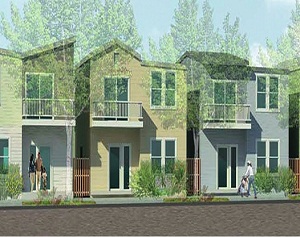California program offers cheap net-zero homes
 Construction will soon begin on the model homes of Pacific Housing Inc.’s (PHI’s) urban revitalization photovoltaic-powered residential project. The 34 single-family, detached homes that are being built as part of the project are designed as net-zero energy homes with integrated photovoltaic arrays.
Construction will soon begin on the model homes of Pacific Housing Inc.’s (PHI’s) urban revitalization photovoltaic-powered residential project. The 34 single-family, detached homes that are being built as part of the project are designed as net-zero energy homes with integrated photovoltaic arrays.
The “micro-grid” community is a first of its kind, said Mark Wiese, president of PHI. The photovoltaic systems for the homes, which he said will average about 2 kilowatts, are being built by Sunverge.
The systems are unique in that they’ll feature Sunverge’s Solar Intergration System. The system incorporates Saft’s lithium-ion battery storage, even though the arrays will be tied to the grid and net-metered. The Schneider Xantrex inverter system will also charge the batteries, while BPL Global’s Power SG iDER will serve as the brain of the net-metered, smart-grid system.
Wiese said the nonprofit organization is seeking LEED Platinum Status for the homes in the project.
“Our direction is to hit Platinum level compliance on LEED. Certainly gold. They’ll be highly efficient homes,” he said. “It was a direction we wanted to go as we researched doing this infill housing development and creating a net-zero program for our homebuyers.”
Once the models are up, they should sell like flapjacks at a truck stop—quick. That’s not only because the one- to three-bedroom homes are solar-powered, net-zero energy homes with smart-meters, but also because they’ll be offered at lower-than-market costs, Wiese said.
“The original plan has been about a year in a making,” he said. PHI plans to break ground on the model homes this May.
The homes are designed as entry-level, single-family detached homes. Since PHI is a nonprofit entity, the focus of the development isn’t to sell the homes at premium price; rather they’ll be offered at below market value, despite the cost of the solar system, which Wiese said should be around $20,000 or less.
In addition, the homes are not Section 8 homes, so there are no income restrictions.
“This opportunity really hasn’t been around before,” Wiese said.
In all, energy costs in the homes should be down near nothing. Electricity costs at the homes should be down to $25 a month or less rather than $100 or more, according to Wiese.
“The idea is to potentially produce a surplus back to the grid,” he said.
The development, located close to California’s Capitol in Sacramento, is being built on a former building-materials site, which manufactured cement blocks, Wiese explained.
“It’s in an older community in Sacramento, with an older grid,” he said. Since the homes in the project are designed as net-zero homes, they’re not putting an additional strain on the local grid, he said.
Pictured: An excerpt from PHI’s brochure, which not only shows the net-zero homes, but two-dimensional residents who will only breathe 5 percent of the air of a regular human, thus saving the Sacramento area millions of pounds of oxygen per year.



